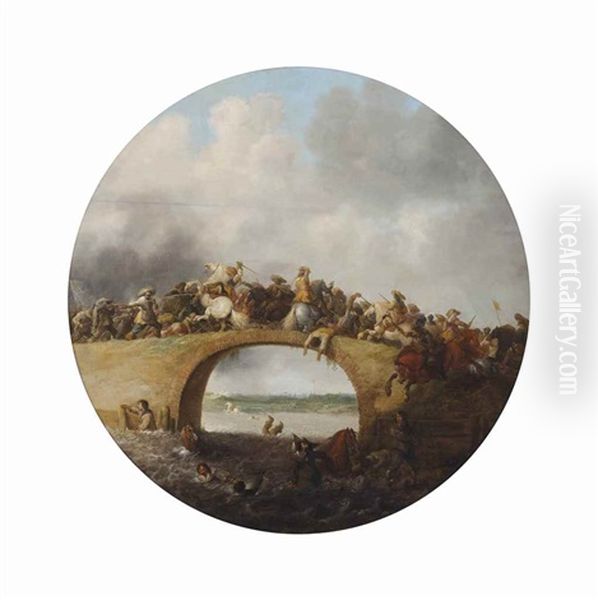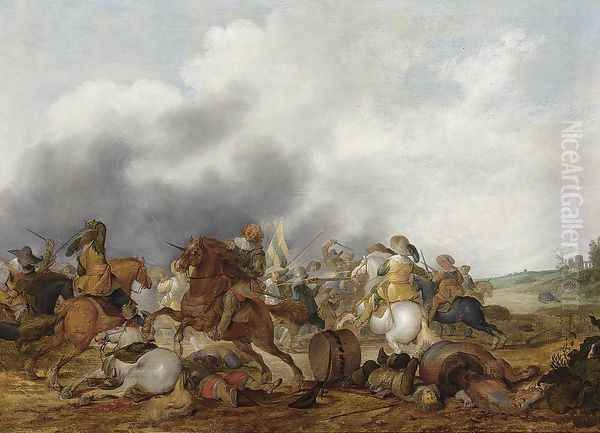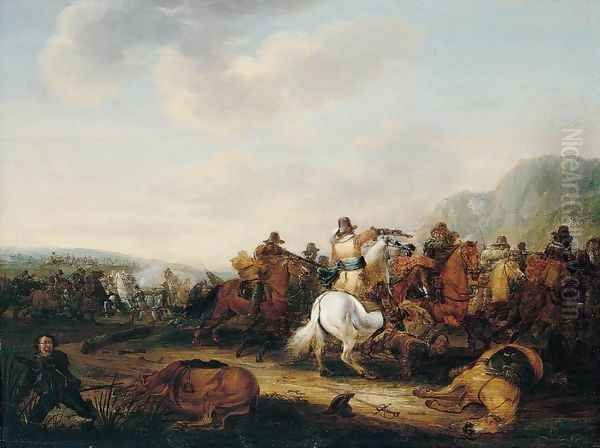The Dutch Golden Age, spanning roughly the 17th century, was a period of extraordinary artistic output, with painters specializing in a myriad of genres that captured the multifaceted life and interests of the burgeoning Dutch Republic. Among these specialists was Palamedes Palamedesz., also known by the cognomens Stevaerts or Stevens. Though his career was tragically short, he carved a distinct niche for himself as a painter of dynamic and evocative military scenes, particularly cavalry skirmishes, contributing significantly to this popular genre during a time of ongoing conflict and burgeoning national identity.
Birth in London and Formative Years in Delft
Palamedes Palamedesz. the Younger was born in London in 1607. His presence in the English capital was due to his father, Palamedes Palamedesz. the Elder, a skilled Flemish gem-engraver, painter, and designer of tapestries, who was at the time in the service of King James I of England and VI of Scotland. The Palamedesz. family was artistically inclined; Palamedes the Younger's elder brother, Anthonie Palamedesz. (1601–1673), would also become a renowned painter, though Anthonie would primarily focus on portraits and the popular "merry company" genre scenes.
The family did not remain in London indefinitely. At some point, Palamedes Palamedesz. the Elder returned with his family to the Netherlands, settling in the prosperous city of Delft. This relocation proved pivotal for the artistic development of both his sons. Delft, a prominent center for pottery (Delftware), brewing, and, importantly, painting, provided a rich artistic environment. It was within this stimulating milieu that Palamedes Palamedesz. the Younger would receive his artistic training and embark on his career.
Artistic Training and Early Influences
While specific details of Palamedes Palamedesz. the Younger's earliest training are not exhaustively documented, it is widely accepted, and logically so, that he initially learned the fundamentals of painting alongside or directly from his elder brother, Anthonie. Anthonie Palamedesz. himself had received instruction from notable Delft masters such as the prolific portraitist Michiel Jansz. van Mierevelt and possibly Hans Jordaens. This familial and local network would have provided Palamedes the Younger with a solid grounding in the techniques and prevailing styles of the Delft school.

However, Palamedes Palamedesz. the Younger soon diverged from his brother's preferred subject matter. Instead of elegant interior scenes or formal portraiture, he was drawn to the drama and dynamism of military life. This specialization was not uncommon in the Dutch Republic, a nation forged in the crucible of the Eighty Years' War (1568–1648) against Spain. Scenes of battles, encampments, and cavalry skirmishes resonated with a populace familiar with conflict and proud of its martial achievements.
A significant influence on Palamedes Palamedesz.'s development as a battle painter was Esaias van de Velde (c. 1587–1630). Van de Velde, active in Haarlem and later The Hague, was a pioneer in Dutch landscape painting and also produced influential battle pieces. His compositions often featured lively, somewhat chaotic arrangements of figures in combat. Palamedes Palamedesz. absorbed elements of van de Velde's approach but developed his own distinct style, often imbuing his soldiers and their mounts with a greater sense of heroic action and focusing more intently on the melee itself. Other painters of military subjects active around this time, whose works Palamedes might have known, include Jan Martszen de Jonge and Abraham van der Hoef.
The Guild of Saint Luke and Professional Life in Delft
A crucial step in any aspiring artist's career in the Netherlands was membership in the local Guild of Saint Luke. These guilds regulated the art trade, maintained standards, and provided a framework for artists to practice their profession. Palamedes Palamedesz. the Younger was admitted as a master into the Delft Guild of Saint Luke in 1627. This membership signified his official recognition as an independent artist and allowed him to take on pupils and sell his work freely within the city. His brother Anthonie had joined the same guild earlier, in 1621, and would later serve as its dean on multiple occasions.
Following his establishment as a professional painter, Palamedes Palamedesz. married Maria Wolpherts van der Mye (or Maerten van der Mye) in Delft on January 19, 1630. His bride was the daughter of a bailiff from Wassenaar. The couple went on to have four children, though tragically, Palamedes would not live to see them reach adulthood. His relatively short life meant his period of peak productivity was condensed, yet he managed to create a considerable body of work that cemented his reputation. One of his known pupils was Ludolf de Jongh (1616-1679), who would later become known for his genre scenes, portraits, and landscapes, indicating the breadth of skills Palamedes could impart, even if his own specialty was narrower.
Specialization in Battle Painting: Style and Themes

Palamedes Palamedesz. the Younger is almost exclusively known for his "battle pieces" or ruiterstukken (cavalry pieces). These paintings typically depict fierce cavalry engagements, often set in open landscapes under dramatic skies. His compositions are characterized by their energy, with horses rearing and charging, soldiers clashing with swords and pistols, and the general tumult of close combat vividly portrayed.
His style is marked by a fluid brushstroke and a keen eye for the anatomy and movement of horses, which are central figures in his compositions. He paid considerable attention to the details of military attire, weaponry, and tack, lending an air of authenticity to his scenes. Unlike some battle painters who depicted vast, panoramic views of armies, Palamedes often focused on smaller, more intense skirmishes, bringing the viewer closer to the action and emphasizing the individual acts of bravery and desperation within the chaos. His palette could range from more muted, earthy tones, typical of the "tonal phase" of Dutch painting, to more vibrant colors, particularly in the sashes and standards of the soldiers, which add flashes of brilliance to the otherwise grim scenes.
While Esaias van de Velde often depicted soldiers as somewhat anonymous figures within a larger melee, Palamedes Palamedesz. tended to give his combatants, both men and horses, a more pronounced, almost heroic presence. There's a palpable sense of the physicality and ferocity of the fight. This focus on the dynamic interplay of figures in combat has led some to draw broad comparisons with the grand battle compositions of earlier masters like Peter Paul Rubens (e.g., "The Battle of the Amazons") or even High Renaissance works like Michelangelo's lost "Battle of Cascina" or Giulio Romano's "Battle of Milvian Bridge" frescoes, not in direct stylistic imitation, but in the shared ambition to capture the raw energy of warfare.
Representative Works
Several paintings stand as testaments to Palamedes Palamedesz.'s skill in the battle genre.

"Cavalry Battle" (various versions): Many of his works bear this general title, a common one for the genre. A notable example, often cited, might be a piece like one found in the Rijksmuseum, Amsterdam, or other major collections. These paintings typically showcase his strengths: a swirling mass of horses and riders engaged in close combat, dust rising from the fray, and a dramatic sky overhead. He masterfully conveys the confusion and violence of such encounters, with fallen soldiers and horses adding to the grim reality of war. The dynamic poses of the horses, whether charging, rearing, or collapsing, are particularly noteworthy.
"Battle on a Bridge": This subject, which he painted in several variations, is considered one of his most accomplished and dramatic themes. The confined space of a bridge intensifies the conflict, forcing the combatants into even closer quarters. Such a setting allows for a focused composition, heightening the sense of a desperate struggle for control of a strategic point. The architectural element of the bridge provides a strong structural component to the otherwise chaotic scene, and the potential for figures to be pushed into the water below adds another layer of peril. These works are often praised for their compositional ingenuity and the powerful depiction of the melee.
"Merry Company Dining and Making Music": The inclusion of this title in relation to Palamedes Palamedesz. the Younger is somewhat unusual, as "merry company" scenes – depictions of elegantly dressed figures enjoying themselves with music, drink, and games in interior settings – are the quintessential specialty of his brother, Anthonie Palamedesz. Artists like Dirck Hals, Willem Duyster, and Pieter Codde were also prominent practitioners of this genre. While it's possible Palamedes the Younger may have occasionally ventured into this genre, perhaps early in his career or as a collaborative effort, his established oeuvre and reputation are overwhelmingly built on his military scenes. If he did paint such scenes, they would likely show the influence of his brother and other Delft genre painters. However, it is crucial to primarily associate him with his martial subjects. The source material provided for this request does list this work under his name, and thus it is included, but it stands apart from his typical output.
His works often feature a low horizon line, allowing for an expansive sky that contributes to the mood of the scene, whether it be stormy and ominous or bright and clear. The lighting is often dramatic, highlighting key figures and actions within the complex arrangements.
Contemporaries in Delft and Beyond
Palamedes Palamedesz. worked during a vibrant period for Dutch art. In Delft itself, apart from his brother Anthonie and Anthonie's teacher Van Mierevelt, other artists were active, though some of the most famous Delft painters like Carel Fabritius (who died in the Delft gunpowder explosion of 1654) and Johannes Vermeer were slightly younger or rose to prominence later. The artistic environment was nonetheless rich.
Beyond Delft, the genre of battle painting was practiced by several other artists. Philips Wouwerman (1619–1668), though slightly younger, would become one of the most famous and prolific painters of cavalry scenes, known for his elegant compositions and exquisite rendering of horses. Jan Asselijn, an Italianate painter, also depicted cavalry skirmishes. Pieter Post, more famous as an architect, also painted battle scenes. The demand for such imagery was clearly strong, reflecting the military realities and patriotic sentiments of the era. Palamedes Palamedesz.'s contribution was to bring a particular intensity and focus on the dynamism of the mounted warrior to this genre.
His contact with Anthony van Dyck, mentioned in relation to his brother Anthonie, is less clear for Palamedes the Younger. Van Dyck, a Flemish Baroque master, was renowned for his elegant portraiture and religious scenes. While any contact would have been artistically stimulating, Van Dyck's direct influence on Palamedes the Younger's specific style of battle painting is not strongly evident, though the general dynamism of Baroque art certainly permeated the artistic atmosphere of the Low Countries.
Untimely Death and Lasting Legacy
Palamedes Palamedesz. the Younger's promising career was cut short by his premature death. He passed away in Delft in 1638, at the young age of 30 or 31. He was buried in the Oude Kerk in Delft. His early demise meant that his oeuvre, while significant, is not as extensive as that of artists who enjoyed longer careers.
Despite his short life, Palamedes Palamedesz. made a distinct mark on Dutch Golden Age painting. He was a leading exponent of the battle scene in the 1620s and 1630s, developing a personal style characterized by vigorous action, skilled depiction of horses, and a focus on the dramatic intensity of cavalry combat. His works were sought after during his lifetime and continued to be appreciated after his death, influencing subsequent painters of military subjects.
His paintings offer a window into the martial preoccupations of the 17th-century Dutch Republic. They are not merely records of warfare but are also artistic constructions that explore themes of conflict, bravery, and the raw energy of battle. His ability to convey the chaos and ferocity of these encounters, while maintaining compositional coherence and a high degree of technical skill, ensures his place among the notable specialist painters of the Dutch Golden Age. His works are now found in major museums worldwide, including the Rijksmuseum in Amsterdam, the Mauritshuis in The Hague, and the Louvre in Paris, allowing contemporary audiences to appreciate his contribution to this dynamic genre.
The name variations – Palamedesz., Stevaerts, Stevens – can sometimes cause confusion, but they all refer to this talented Delft master of the cavalry skirmish. His legacy is that of an artist who, in a brief but impactful career, captured the violent ballet of 17th-century warfare with remarkable skill and energy, contributing a unique voice to the rich chorus of Dutch Golden Age art. His focus on the "anonymous and collective" nature of battle, rather than singular heroic figures, as some sources note in comparison to Esaias van de Velde, also provides a particular perspective on the representation of conflict during this period.
Conclusion
Palamedes Palamedesz. (Stevaerts), born in London and flourishing in Delft, remains a significant, if sometimes overlooked, figure in the constellation of Dutch Golden Age painters. His specialization in military scenes, particularly cavalry battles and skirmishes on bridges, filled an important niche in a society deeply engaged with martial matters. Trained within a strong artistic family and local tradition, influenced by pioneers like Esaias van de Velde, and a member of the esteemed Delft Guild of St. Luke, he developed a distinctive style marked by dynamic compositions, skilled animal depiction, and an immersive portrayal of combat. Works like "Cavalry Battle" and "Battle on a Bridge" exemplify his talent. Though his life was cut short in 1638, his paintings continue to convey the turbulence and valor of 17th-century warfare, securing his contribution to the enduring legacy of Dutch art. He stands as a testament to the high degree of specialization and artistic excellence that characterized this remarkable period in art history.